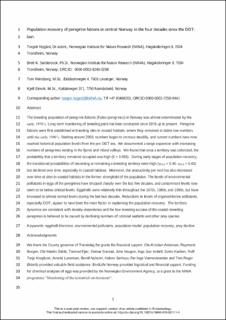Population recovery of peregrine falcons in central Norway in the 4 decades since the DDT-ban
Peer reviewed, Journal article
Accepted version

Åpne
Permanent lenke
https://hdl.handle.net/11250/3056503Utgivelsesdato
2019Metadata
Vis full innførselSamlinger
- Publikasjoner fra CRIStin - NINA [2364]
- Scientific publications [1392]
Originalversjon
10.1007/s10646-019-02111-4Sammendrag
The breeding population of peregrine falcons (Falco peregrinus) in Norway was almost exterminated by the early 1970’s. Long-term monitoring of breeding pairs has been conducted since 1976 up to present. Peregrine falcons were first established at breeding sites in coastal habitats, where they remained at stable low numbers until the early 1990’s. Starting around 2000, numbers began to increase steadily, and current numbers have now reached historical population levels from the pre-DDT era. We documented a range expansion with increasing numbers of peregrines nesting in the fjords and inland valleys. We found that once a territory was colonized, the probability that a territory remained occupied was high (S > 0.958). During early stages of population recovery, the transitional probabilities of becoming or remaining a breeding territory were high (ψN–B > 0.40, ψB–B > 0.65) but declined over time, especially in coastal habitats. Moreover, the productivity per nest has also decreased over time at sites in coastal habitats in the former stronghold of the population. The levels of environmental pollutants in eggs of the peregrines have dropped sharply over the last few decades, and contaminant levels now seem to be below critical levels. Eggshells were relatively thin throughout the 1970s, 1980s, and 1990s, but have increased to almost normal levels during the last 2 decades. Reductions in levels of organochlorine pollutants, especially DDT, appear to have been the main factor in explaining the population recovery. The territory dynamics are consistent With density-dependence and the low breeding success of the coastal-breeding peregrines is believed to be caused by declining numbers of colonial seabirds and other prey species. Eggshell thickness ● Environmental pollutants ● Population model ● Population recovery ● Prey decline